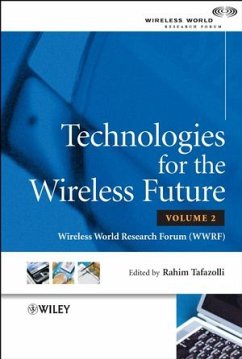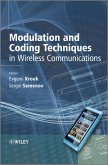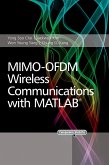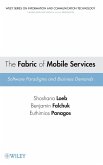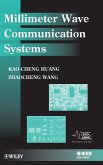Rahim Tafazolli (ed.)Wireless World Research Forum (Wwrf)
Technologies for the Wireless Future, Volume 2
Wireless World Research Forum (Wwrf)
Herausgeber: Tafazolli, Rahim
Schade – dieser Artikel ist leider ausverkauft. Sobald wir wissen, ob und wann der Artikel wieder verfügbar ist, informieren wir Sie an dieser Stelle.
Rahim Tafazolli (ed.)Wireless World Research Forum (Wwrf)
Technologies for the Wireless Future, Volume 2
Wireless World Research Forum (Wwrf)
Herausgeber: Tafazolli, Rahim
- Gebundenes Buch
- Merkliste
- Auf die Merkliste
- Bewerten Bewerten
- Teilen
- Produkt teilen
- Produkterinnerung
- Produkterinnerung
As 3G mobile communication systems are being deployed, the research community is now focusing on the research needed for the long-term evolution of 3G and 4G systems. This fully updated second volume of the successful Technologies for the Wireless Future is a unique and timely book, presenting up-to-the-minute ideas and trends in mobile communications. The result of pioneering cooperative work of many academic and industrial researchers from WWRF, this comprehensive single point of reference examines the specifications and requirements of 4G and identifying potential business models, research…mehr
Andere Kunden interessierten sich auch für
![Channel-Adaptive Technologies and Cross-Layer Designs for Wireless Systems with Multiple Antennas Channel-Adaptive Technologies and Cross-Layer Designs for Wireless Systems with Multiple Antennas]() Vincent K N LauChannel-Adaptive Technologies and Cross-Layer Designs for Wireless Systems with Multiple Antennas186,99 €
Vincent K N LauChannel-Adaptive Technologies and Cross-Layer Designs for Wireless Systems with Multiple Antennas186,99 €![Wireless Broadband Networks Wireless Broadband Networks]() David T WongWireless Broadband Networks184,99 €
David T WongWireless Broadband Networks184,99 €![Modulation and Coding Techniques in Wireless Communications Modulation and Coding Techniques in Wireless Communications]() Modulation and Coding Techniques in Wireless Communications152,99 €
Modulation and Coding Techniques in Wireless Communications152,99 €![Mimo-Ofdm Wireless Communications with MATLAB Mimo-Ofdm Wireless Communications with MATLAB]() Yong Soo ChoMimo-Ofdm Wireless Communications with MATLAB186,99 €
Yong Soo ChoMimo-Ofdm Wireless Communications with MATLAB186,99 €![Ground-Based Wireless Positioning Ground-Based Wireless Positioning]() Kegen YuGround-Based Wireless Positioning137,99 €
Kegen YuGround-Based Wireless Positioning137,99 €![The Fabric of Mobile Services The Fabric of Mobile Services]() Shoshana LoebThe Fabric of Mobile Services131,99 €
Shoshana LoebThe Fabric of Mobile Services131,99 €![Millimeter Wave Communication Systems Millimeter Wave Communication Systems]() Kao-Cheng HuangMillimeter Wave Communication Systems145,99 €
Kao-Cheng HuangMillimeter Wave Communication Systems145,99 €-
-
As 3G mobile communication systems are being deployed, the research community is now focusing on the research needed for the long-term evolution of 3G and 4G systems. This fully updated second volume of the successful Technologies for the Wireless Future is a unique and timely book, presenting up-to-the-minute ideas and trends in mobile communications. The result of pioneering cooperative work of many academic and industrial researchers from WWRF, this comprehensive single point of reference examines the specifications and requirements of 4G and identifying potential business models, research areas and required spectrum and enabling technologies. Features a wealth of new material, including three new chapters on short-range wireless communications, security and trust, and self-organisation in communication networks, new coverage of reconfigurability, ad hoc networking and multi-user MIMO. The content will have wide-ranging appeal to engineers, researchers, managers and students with an interest in the future of wireless.
Produktdetails
- Produktdetails
- Verlag: John Wiley & Sons / Wiley
- Seitenzahl: 520
- Erscheinungstermin: 1. Juni 2006
- Englisch
- Abmessung: 249mm x 172mm x 35mm
- Gewicht: 1116g
- ISBN-13: 9780470029053
- ISBN-10: 0470029056
- Artikelnr.: 21344827
- Herstellerkennzeichnung
- Libri GmbH
- Europaallee 1
- 36244 Bad Hersfeld
- gpsr@libri.de
- Verlag: John Wiley & Sons / Wiley
- Seitenzahl: 520
- Erscheinungstermin: 1. Juni 2006
- Englisch
- Abmessung: 249mm x 172mm x 35mm
- Gewicht: 1116g
- ISBN-13: 9780470029053
- ISBN-10: 0470029056
- Artikelnr.: 21344827
- Herstellerkennzeichnung
- Libri GmbH
- Europaallee 1
- 36244 Bad Hersfeld
- gpsr@libri.de
Professor Rahim Tafazolli is Head of the Mobile Communications Research Group at the Centre for Communication Systems Research, University of Surrey, UK. His research activities are on optimization techniques for mobile multimedia networks, mainly on advance Resource management, Mobility management and Media Access Control. He has published more than 300 research papers in refereed journals, international conferences and as invited speaker, and has more than 15 patents in the field of mobile communications. He is the founder and past Chairman of International Conference on "3G Mobile Technologies". He is also member of IEE Committee on the UK Regulations on "Information Technology & Telecommunications", a member of the WWRF Vision Committee, and past Chairman of "New Technologies" group of Wireless World Research Forum (WWRF), and academic co-ordinator of the UK Mobile VCE (Virtual Centre of Excellence).
List of Figures.
List of Tables.
List of Contributors.
Foreword by Nim Cheung.
Foreword by Xiao-Hu You.
Preface.
Acknowledgements.
1. Introduction Edited by Mikko Uusitalo (Nokia).
1.1 Goals and Objectives - Shaping the Global Wireless Future.
1.2 Structure of WWRF.
1.3 The International Context and B3G/4G Activities.
1.4 Acknowledgement.
References.
2. Vision and Requirements of the Wireless World Edited by Mikko Uusitalo
(Nokia).
2.1 What we are Observing Today in 2005.
2.2 What is on the Way for 2010?
2.3 Projection for 2017.
2.4 Acknowledgement.
3. User Requirements and Expectations Edited by Angela Sasse (University
College London, UK).
3.1 Introduction.
3.2 The Role of Scenarios in The Development of Future Wireless
Technologies and Services.
3.3 Advanced User Interfaces for Future Mobile Devices.
3.4 Acknowledgment.
References.
4. Service Infrastructures Edited by Stefan Arbanowski (Fraunhofer FOKUS,
Germany) and Wolfgang Kellerer (DoCoMo Euro-Labs, Germany).
4.1 Introduction.
4.2 Requirements for Future Service Platform Architectures.
4.3 Generic Service Elements and Enabling Technologies.
4.4 Acknowledgment.
References.
5. Security and Trust Edited by Mario Hoffmann (Fraunhofer SIT), Christos
Xenakis, Stauraleni Kontopoulou (University of Athens), Markus Eisenhauer
(Fraunhofer FIT), Seppo Heikkinen (Elisa R&D), Antonio Pescape (University
of Naples) and Hu Wang (Huawei).
5.1 Introduction.
5.2 Trust Management in Ubiquitous Computing.
5.3 Identity Management.
5.4 Malicious Code.
5.5 Future Steps.
5.6 Acknowledgement 129
References 129
6. New Air-interface Technologies and Deployment Concepts Edited by David
Falconer (Carleton University), Angeliki Alexiou (Lucent Technologies),
Stefan Kaiser (DoCoMo Euro-Labs), Martin Haardt (Ilmenau University of
Technology) and Tommi Jäamsä (Elektrobit Testing Ltd).
6.1 Introduction.
6.2 Broadband Frequency-domain-based Air-interfaces.
6.3 Smart Antennas, MIMO Systems and Related Technologies.
6.4 Duplexing, Resource Allocation and Inter-cell Coordination.
6.5 Multidimensional Radio Channel Measurement and Modeling.
6.6 Acknowledgment.
References.
7. Short-range Wireless Communications Edited by Gerhard Fettweis (Vodafone
Chair, TU Dresden), Ernesto Zimmermann (Vodafone Chair, TU Dresden), Ben
Allen (King's College London), Dominic C. O'Brien (University of Oxford)
and Pierre Chevillat (IBM Research GmbH, Zurich Research Laboratory).
7.1 Introduction.
7.2 MIMO-OFDM in the TDD Mode.
7.3 Ultra-wideband: Technology and Future Perspectives.
7.4 Wireless Optical Communication.
7.5 Wireless Sensor Networks.
7.6 Acknowledgment.
References.
8. Reconfigurability Edited by Panagiotis Demestichas (University of
Piraeus), George Dimitrakopoulos (University of Piraeus), Klaus M¿oßner
(CCSR, University of Surrey), Terence Dodgson (Samsung Electronics) and
Didier Bourse (Motorola Labs).
8.1 Introduction.
8.2 Application Scenarios for Reconfigurability.
8.3 Element Management, Flexible Air Interfaces and SDR.
8.4 Network Architecture and Support Services.
8.5 Cognitive Radio, Spectrum and Radio Resource Management.
8.6 Acknowledgement.
References.
9. Self-organization in Communication Networks Edited by Amardeo Sarma
(NEC), Christian Bettstetter (DoCoMo) and Sudhir Dixit (Nokia).
9.1 Introduction and Motivation.
9.2 Self-organization in Today's Internet.
9.3 Self-organization in Ad Hoc and Sensor Networks.
9.4 Self-organization in Network Management.
9.5 Graph-theoretical Aspects of Self-organization.
9.6 Potential and Limitations of Self-organization.
9.7 Acknowledgement.
References.
Appendix: Glossary.
Index.
List of Tables.
List of Contributors.
Foreword by Nim Cheung.
Foreword by Xiao-Hu You.
Preface.
Acknowledgements.
1. Introduction Edited by Mikko Uusitalo (Nokia).
1.1 Goals and Objectives - Shaping the Global Wireless Future.
1.2 Structure of WWRF.
1.3 The International Context and B3G/4G Activities.
1.4 Acknowledgement.
References.
2. Vision and Requirements of the Wireless World Edited by Mikko Uusitalo
(Nokia).
2.1 What we are Observing Today in 2005.
2.2 What is on the Way for 2010?
2.3 Projection for 2017.
2.4 Acknowledgement.
3. User Requirements and Expectations Edited by Angela Sasse (University
College London, UK).
3.1 Introduction.
3.2 The Role of Scenarios in The Development of Future Wireless
Technologies and Services.
3.3 Advanced User Interfaces for Future Mobile Devices.
3.4 Acknowledgment.
References.
4. Service Infrastructures Edited by Stefan Arbanowski (Fraunhofer FOKUS,
Germany) and Wolfgang Kellerer (DoCoMo Euro-Labs, Germany).
4.1 Introduction.
4.2 Requirements for Future Service Platform Architectures.
4.3 Generic Service Elements and Enabling Technologies.
4.4 Acknowledgment.
References.
5. Security and Trust Edited by Mario Hoffmann (Fraunhofer SIT), Christos
Xenakis, Stauraleni Kontopoulou (University of Athens), Markus Eisenhauer
(Fraunhofer FIT), Seppo Heikkinen (Elisa R&D), Antonio Pescape (University
of Naples) and Hu Wang (Huawei).
5.1 Introduction.
5.2 Trust Management in Ubiquitous Computing.
5.3 Identity Management.
5.4 Malicious Code.
5.5 Future Steps.
5.6 Acknowledgement 129
References 129
6. New Air-interface Technologies and Deployment Concepts Edited by David
Falconer (Carleton University), Angeliki Alexiou (Lucent Technologies),
Stefan Kaiser (DoCoMo Euro-Labs), Martin Haardt (Ilmenau University of
Technology) and Tommi Jäamsä (Elektrobit Testing Ltd).
6.1 Introduction.
6.2 Broadband Frequency-domain-based Air-interfaces.
6.3 Smart Antennas, MIMO Systems and Related Technologies.
6.4 Duplexing, Resource Allocation and Inter-cell Coordination.
6.5 Multidimensional Radio Channel Measurement and Modeling.
6.6 Acknowledgment.
References.
7. Short-range Wireless Communications Edited by Gerhard Fettweis (Vodafone
Chair, TU Dresden), Ernesto Zimmermann (Vodafone Chair, TU Dresden), Ben
Allen (King's College London), Dominic C. O'Brien (University of Oxford)
and Pierre Chevillat (IBM Research GmbH, Zurich Research Laboratory).
7.1 Introduction.
7.2 MIMO-OFDM in the TDD Mode.
7.3 Ultra-wideband: Technology and Future Perspectives.
7.4 Wireless Optical Communication.
7.5 Wireless Sensor Networks.
7.6 Acknowledgment.
References.
8. Reconfigurability Edited by Panagiotis Demestichas (University of
Piraeus), George Dimitrakopoulos (University of Piraeus), Klaus M¿oßner
(CCSR, University of Surrey), Terence Dodgson (Samsung Electronics) and
Didier Bourse (Motorola Labs).
8.1 Introduction.
8.2 Application Scenarios for Reconfigurability.
8.3 Element Management, Flexible Air Interfaces and SDR.
8.4 Network Architecture and Support Services.
8.5 Cognitive Radio, Spectrum and Radio Resource Management.
8.6 Acknowledgement.
References.
9. Self-organization in Communication Networks Edited by Amardeo Sarma
(NEC), Christian Bettstetter (DoCoMo) and Sudhir Dixit (Nokia).
9.1 Introduction and Motivation.
9.2 Self-organization in Today's Internet.
9.3 Self-organization in Ad Hoc and Sensor Networks.
9.4 Self-organization in Network Management.
9.5 Graph-theoretical Aspects of Self-organization.
9.6 Potential and Limitations of Self-organization.
9.7 Acknowledgement.
References.
Appendix: Glossary.
Index.
List of Figures.
List of Tables.
List of Contributors.
Foreword by Nim Cheung.
Foreword by Xiao-Hu You.
Preface.
Acknowledgements.
1. Introduction Edited by Mikko Uusitalo (Nokia).
1.1 Goals and Objectives - Shaping the Global Wireless Future.
1.2 Structure of WWRF.
1.3 The International Context and B3G/4G Activities.
1.4 Acknowledgement.
References.
2. Vision and Requirements of the Wireless World Edited by Mikko Uusitalo
(Nokia).
2.1 What we are Observing Today in 2005.
2.2 What is on the Way for 2010?
2.3 Projection for 2017.
2.4 Acknowledgement.
3. User Requirements and Expectations Edited by Angela Sasse (University
College London, UK).
3.1 Introduction.
3.2 The Role of Scenarios in The Development of Future Wireless
Technologies and Services.
3.3 Advanced User Interfaces for Future Mobile Devices.
3.4 Acknowledgment.
References.
4. Service Infrastructures Edited by Stefan Arbanowski (Fraunhofer FOKUS,
Germany) and Wolfgang Kellerer (DoCoMo Euro-Labs, Germany).
4.1 Introduction.
4.2 Requirements for Future Service Platform Architectures.
4.3 Generic Service Elements and Enabling Technologies.
4.4 Acknowledgment.
References.
5. Security and Trust Edited by Mario Hoffmann (Fraunhofer SIT), Christos
Xenakis, Stauraleni Kontopoulou (University of Athens), Markus Eisenhauer
(Fraunhofer FIT), Seppo Heikkinen (Elisa R&D), Antonio Pescape (University
of Naples) and Hu Wang (Huawei).
5.1 Introduction.
5.2 Trust Management in Ubiquitous Computing.
5.3 Identity Management.
5.4 Malicious Code.
5.5 Future Steps.
5.6 Acknowledgement 129
References 129
6. New Air-interface Technologies and Deployment Concepts Edited by David
Falconer (Carleton University), Angeliki Alexiou (Lucent Technologies),
Stefan Kaiser (DoCoMo Euro-Labs), Martin Haardt (Ilmenau University of
Technology) and Tommi Jäamsä (Elektrobit Testing Ltd).
6.1 Introduction.
6.2 Broadband Frequency-domain-based Air-interfaces.
6.3 Smart Antennas, MIMO Systems and Related Technologies.
6.4 Duplexing, Resource Allocation and Inter-cell Coordination.
6.5 Multidimensional Radio Channel Measurement and Modeling.
6.6 Acknowledgment.
References.
7. Short-range Wireless Communications Edited by Gerhard Fettweis (Vodafone
Chair, TU Dresden), Ernesto Zimmermann (Vodafone Chair, TU Dresden), Ben
Allen (King's College London), Dominic C. O'Brien (University of Oxford)
and Pierre Chevillat (IBM Research GmbH, Zurich Research Laboratory).
7.1 Introduction.
7.2 MIMO-OFDM in the TDD Mode.
7.3 Ultra-wideband: Technology and Future Perspectives.
7.4 Wireless Optical Communication.
7.5 Wireless Sensor Networks.
7.6 Acknowledgment.
References.
8. Reconfigurability Edited by Panagiotis Demestichas (University of
Piraeus), George Dimitrakopoulos (University of Piraeus), Klaus M¿oßner
(CCSR, University of Surrey), Terence Dodgson (Samsung Electronics) and
Didier Bourse (Motorola Labs).
8.1 Introduction.
8.2 Application Scenarios for Reconfigurability.
8.3 Element Management, Flexible Air Interfaces and SDR.
8.4 Network Architecture and Support Services.
8.5 Cognitive Radio, Spectrum and Radio Resource Management.
8.6 Acknowledgement.
References.
9. Self-organization in Communication Networks Edited by Amardeo Sarma
(NEC), Christian Bettstetter (DoCoMo) and Sudhir Dixit (Nokia).
9.1 Introduction and Motivation.
9.2 Self-organization in Today's Internet.
9.3 Self-organization in Ad Hoc and Sensor Networks.
9.4 Self-organization in Network Management.
9.5 Graph-theoretical Aspects of Self-organization.
9.6 Potential and Limitations of Self-organization.
9.7 Acknowledgement.
References.
Appendix: Glossary.
Index.
List of Tables.
List of Contributors.
Foreword by Nim Cheung.
Foreword by Xiao-Hu You.
Preface.
Acknowledgements.
1. Introduction Edited by Mikko Uusitalo (Nokia).
1.1 Goals and Objectives - Shaping the Global Wireless Future.
1.2 Structure of WWRF.
1.3 The International Context and B3G/4G Activities.
1.4 Acknowledgement.
References.
2. Vision and Requirements of the Wireless World Edited by Mikko Uusitalo
(Nokia).
2.1 What we are Observing Today in 2005.
2.2 What is on the Way for 2010?
2.3 Projection for 2017.
2.4 Acknowledgement.
3. User Requirements and Expectations Edited by Angela Sasse (University
College London, UK).
3.1 Introduction.
3.2 The Role of Scenarios in The Development of Future Wireless
Technologies and Services.
3.3 Advanced User Interfaces for Future Mobile Devices.
3.4 Acknowledgment.
References.
4. Service Infrastructures Edited by Stefan Arbanowski (Fraunhofer FOKUS,
Germany) and Wolfgang Kellerer (DoCoMo Euro-Labs, Germany).
4.1 Introduction.
4.2 Requirements for Future Service Platform Architectures.
4.3 Generic Service Elements and Enabling Technologies.
4.4 Acknowledgment.
References.
5. Security and Trust Edited by Mario Hoffmann (Fraunhofer SIT), Christos
Xenakis, Stauraleni Kontopoulou (University of Athens), Markus Eisenhauer
(Fraunhofer FIT), Seppo Heikkinen (Elisa R&D), Antonio Pescape (University
of Naples) and Hu Wang (Huawei).
5.1 Introduction.
5.2 Trust Management in Ubiquitous Computing.
5.3 Identity Management.
5.4 Malicious Code.
5.5 Future Steps.
5.6 Acknowledgement 129
References 129
6. New Air-interface Technologies and Deployment Concepts Edited by David
Falconer (Carleton University), Angeliki Alexiou (Lucent Technologies),
Stefan Kaiser (DoCoMo Euro-Labs), Martin Haardt (Ilmenau University of
Technology) and Tommi Jäamsä (Elektrobit Testing Ltd).
6.1 Introduction.
6.2 Broadband Frequency-domain-based Air-interfaces.
6.3 Smart Antennas, MIMO Systems and Related Technologies.
6.4 Duplexing, Resource Allocation and Inter-cell Coordination.
6.5 Multidimensional Radio Channel Measurement and Modeling.
6.6 Acknowledgment.
References.
7. Short-range Wireless Communications Edited by Gerhard Fettweis (Vodafone
Chair, TU Dresden), Ernesto Zimmermann (Vodafone Chair, TU Dresden), Ben
Allen (King's College London), Dominic C. O'Brien (University of Oxford)
and Pierre Chevillat (IBM Research GmbH, Zurich Research Laboratory).
7.1 Introduction.
7.2 MIMO-OFDM in the TDD Mode.
7.3 Ultra-wideband: Technology and Future Perspectives.
7.4 Wireless Optical Communication.
7.5 Wireless Sensor Networks.
7.6 Acknowledgment.
References.
8. Reconfigurability Edited by Panagiotis Demestichas (University of
Piraeus), George Dimitrakopoulos (University of Piraeus), Klaus M¿oßner
(CCSR, University of Surrey), Terence Dodgson (Samsung Electronics) and
Didier Bourse (Motorola Labs).
8.1 Introduction.
8.2 Application Scenarios for Reconfigurability.
8.3 Element Management, Flexible Air Interfaces and SDR.
8.4 Network Architecture and Support Services.
8.5 Cognitive Radio, Spectrum and Radio Resource Management.
8.6 Acknowledgement.
References.
9. Self-organization in Communication Networks Edited by Amardeo Sarma
(NEC), Christian Bettstetter (DoCoMo) and Sudhir Dixit (Nokia).
9.1 Introduction and Motivation.
9.2 Self-organization in Today's Internet.
9.3 Self-organization in Ad Hoc and Sensor Networks.
9.4 Self-organization in Network Management.
9.5 Graph-theoretical Aspects of Self-organization.
9.6 Potential and Limitations of Self-organization.
9.7 Acknowledgement.
References.
Appendix: Glossary.
Index.

